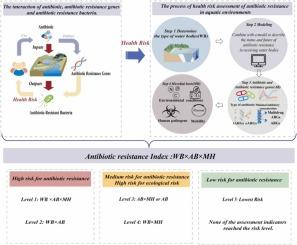水生环境抗生素耐药性健康风险评估的综合框架:现状、进展与展望
IF 11.3
1区 环境科学与生态学
Q1 ENGINEERING, ENVIRONMENTAL
引用次数: 0
摘要
抗生素耐药性(AR)是由抗生素作为新兴污染物驱动的,已成为严重的全球健康威胁,危害环境和人类健康。抗生素、抗生素耐药基因(ARGs)和抗生素耐药细菌(ARB)之间复杂的相互作用决定了AR在水生生态系统中的持续和传播,这些相互作用共同影响着其在水生生态系统中的发生、运输和命运。然而,大多数评估主要侧重于抗生素和ARG,往往依赖于单因素标准,而忽略了关键的影响因素,如ARG形式、非抗生素化学品、抗生素压力和微生物竞争。此外,许多方法未能纳入潜在的未来风险,限制了它们在解决水生环境中AR的预测准确性和整体有效性。为了弥补这些研究空白,我们引入了一个综合的健康风险评估框架,该框架整合了抗生素、ARGs和ARB之间的相互作用。建议的方法包括四个步骤:1。确定水体类型;2. 进行模型仿真;3. 评估抗生素和ARGs;和4。评估ARB。最后,建立了AR的综合风险指标,并建立了相应的分级风险排名体系。此外,为了验证该框架的实际应用,以东北典型湖泊为例进行了抗生素耐药风险评估,验证了该框架在量化AR多维健康风险方面的有效性。该框架不仅为动态健康风险评估提供了重要的基础,而且还为动态健康风险评估提供了基础。但也为未来更有效的缓解战略铺平了道路,以保护水生生态系统和人类健康。本文章由计算机程序翻译,如有差异,请以英文原文为准。

A Comprehensive Framework of Health Risk Assessment for Antibiotic Resistance in Aquatic Environments: Status, Progress, and Perspectives
Antibiotic resistance (AR), driven by antibiotics as emerging pollutants, has become a critical global health threat, jeopardizing both environmental and human health. The persistence and spread of AR in aquatic ecosystems are governed by the intricate interplay between antibiotics, antibiotic resistance genes (ARGs), and antibiotic-resistant bacteria (ARB), which collectively influences its occurrence, transportation, and fate in aquatic ecosystems. However, most assessments focus primarily on antibiotics and ARGs, often relying on single-factor criteria while overlooking critical influence factors such as ARG forms, non-antibiotic chemicals, antibiotic pressure, and microbial competition. Furthermore, many fail to incorporate potential future risks, limiting their predictive accuracy and overall effectiveness in addressing AR in aquatic environments. To bridge these research gaps, we introduce a comprehensive health risk assessment framework that integrates the interactions among antibiotics, ARGs, and ARB. The proposed approach comprises four steps: 1. Determining the type of water body; 2. Performing model simulations; 3. Assessing antibiotics and ARGs; and 4. Evaluating ARB. Finally, a comprehensive risk index for AR is established, along with a corresponding hierarchical risk ranking system. Moreover, to demonstrate the practical application of the framework, an assessment of antibiotic resistance risk was conducted using a typical lake in Northeast China as a case study, indicating the efficacy of the proposed framework in quantifying the multidimensional health risk of AR. This framework not only provides a crucial foundation for dynamic health risk assessment, but also paving the way for more effective mitigation strategies to safeguard both aquatic ecosystems and human health in the future.
求助全文
通过发布文献求助,成功后即可免费获取论文全文。
去求助
来源期刊

Journal of Hazardous Materials
工程技术-工程:环境
CiteScore
25.40
自引率
5.90%
发文量
3059
审稿时长
58 days
期刊介绍:
The Journal of Hazardous Materials serves as a global platform for promoting cutting-edge research in the field of Environmental Science and Engineering. Our publication features a wide range of articles, including full-length research papers, review articles, and perspectives, with the aim of enhancing our understanding of the dangers and risks associated with various materials concerning public health and the environment. It is important to note that the term "environmental contaminants" refers specifically to substances that pose hazardous effects through contamination, while excluding those that do not have such impacts on the environment or human health. Moreover, we emphasize the distinction between wastes and hazardous materials in order to provide further clarity on the scope of the journal. We have a keen interest in exploring specific compounds and microbial agents that have adverse effects on the environment.
 求助内容:
求助内容: 应助结果提醒方式:
应助结果提醒方式:


